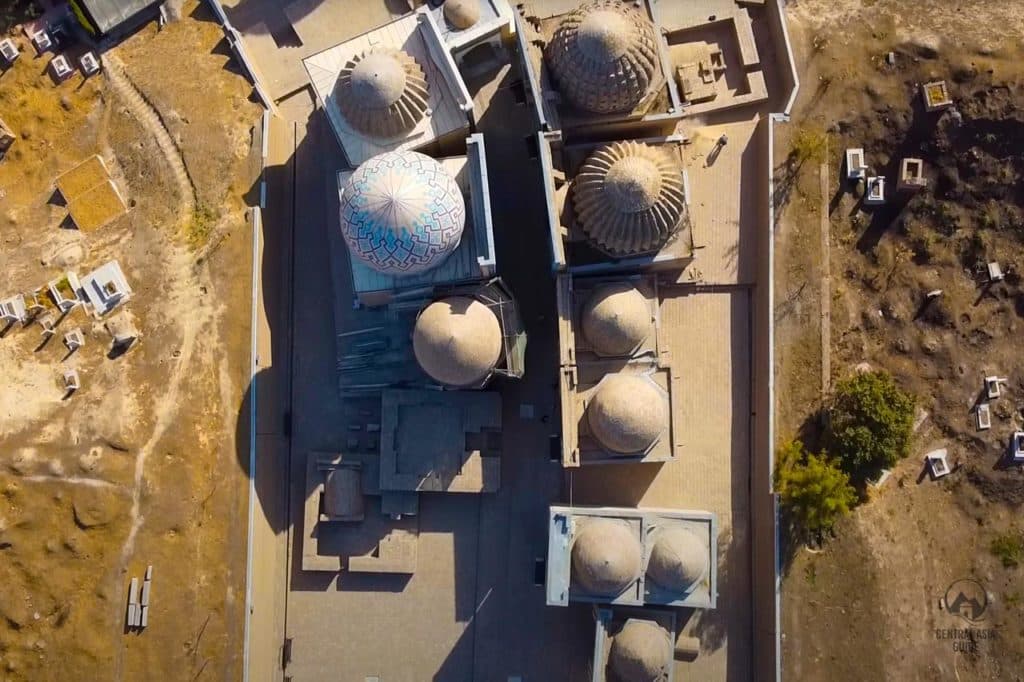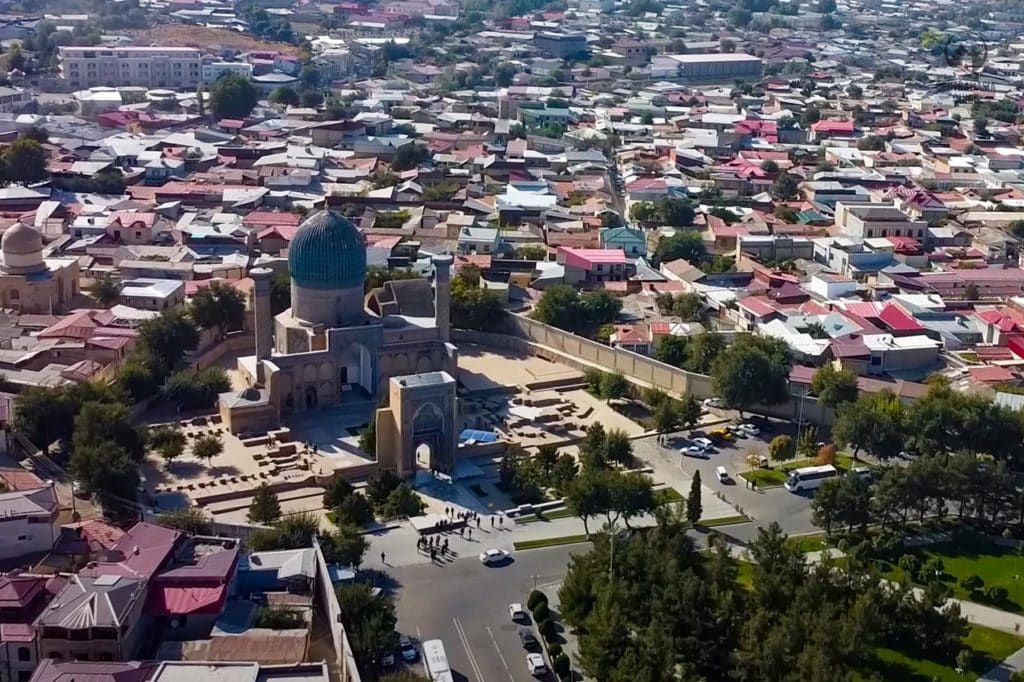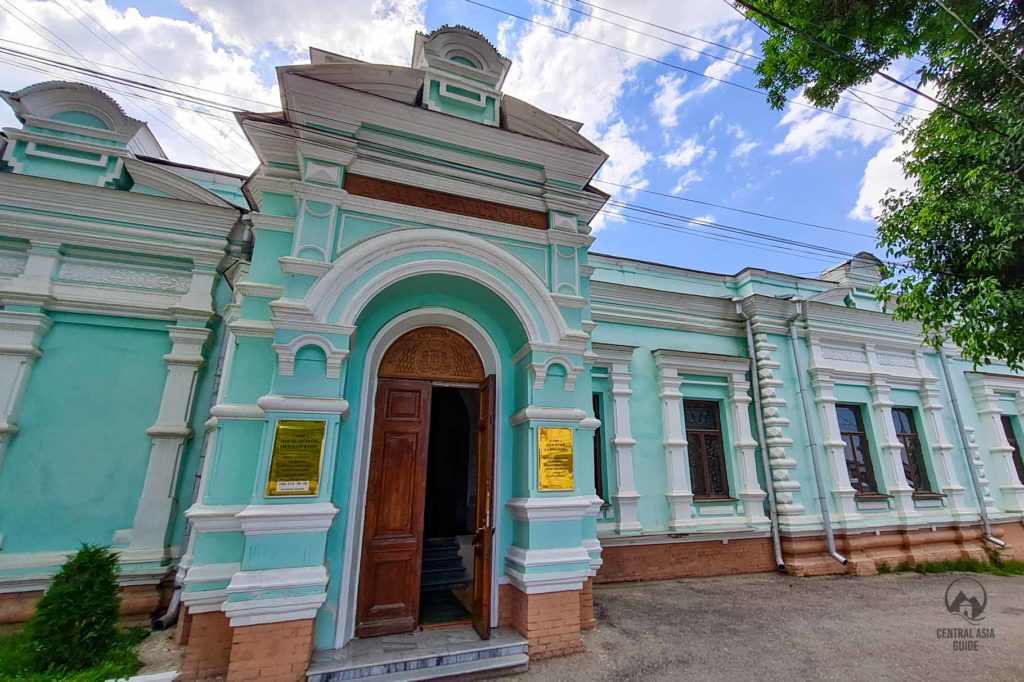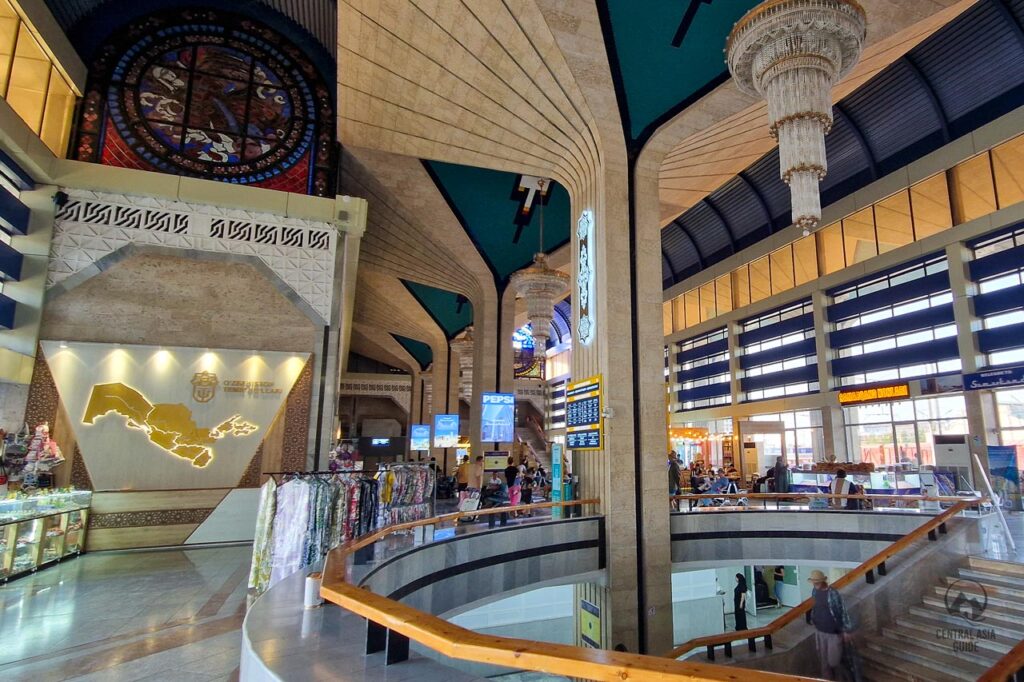Samarkand
Samarkand
Samarkand (or Samarqand) is one of the oldest cities on Earth with its age being close to 3000 years. Samarkand was the center of trade in the middle of the Great Silk Road and during the Middle ages while science and especially medicine and astronomy were ahead of all other regions of the world here. Samarkand is also know as the capital of Tamerlane (or Amir Timur), the Uzbek national hero who during the 15th century managed to conquer the lands where Afghanistan, Pakistan, Iran, Azerbaijan, partially Russia, Kazakhstan, partially China and India now reside. His name can be still seen all around Uzbekistan in the names of streets, squares, avenues and parks.
In addition to the spectacular monuments of the Timurid dynasty and the ruins of the Afrasiyab city, there is not a huge quantity of sights to discover in Samarkand. It is a city of half a million inhabitants and has therefore a feeling of a lot smaller city than for example the busy Tashkent. The historic center of Samarkand is not as well preserved as for example in Bukhara and is spread around in several small pockets around the city. This all being said, it is still easily worth a day or two while visiting Uzbekistan and best enjoyed as a part of one of our Uzbekistan tours or Central Asia Tours.


Samarkand Table of Contents
History of Samarkand
Samarkand was founded already in 742 BC. Due to its convenient geographical location, surrounded by India, China and Persia, Samarkand was one of the main points on the trading routes, including the peak of Silk Road, for 20 centuries and was a cradle of science in the middle ages. The history of the city is very long and dramatic. In the very beginning of its organized history, it was a part of the Sogdian civilization that prospered in may parts of Central Asia. In 329 BC it was conquered by Alexander the Great and was given the name of Maracanda.
For more than a century, in the period from 875 to 999, this settlement, stunning in its beauty and grandeur, was considered one of the largest political and cultural centers of the Samanid Empire. For 17 years Samarkand even bore the title of the capital of this state. Like almost everything in Central Asia, it was destroyed by the Tatar-Mongols, led by Genghis Khan. Tamerlane helped to revive the city and thanks to him, Samarkand grew and received the status of a capital city.


Tamerlane’s grandson, Ulugbek, continued the work of his grandfather and developed the city further by building a large number of madrasas and other buildings. At this time Samarkand became the scientific center of the east. The architectural masterpieces erected during the time of Tamerlane have mostly survived to this day in very good condition. Later, Samarkand was part of the Bukhara Khanate and also ruled under the Bukharan emirs. Samarkand also played an important historical role during the time of the Uzbek SSR as it was the main city of the Soviet state from 1925 to 1930.
Must See Sights in Samarkand
During the almost three thousand years of Samarkand’s existence, Alexander the Great, Genghis Khan and Tamerlane have visited it. Tamerlane made Samarkand the capital of his empire and built palaces and mosques of indescribable beauty in it. These architectural ensembles are included in the UNESCO World Heritage List, and it is quite possible to see most of them even during a short weekend visit.


Samarkand Registan
Registan was the main trading square of ancient Samarkand and still holds its grandeur in the very central location of modern Samarkand. It is also the number one sight to see while in Samarkand.
Shah-i-Zinda Necropolis
Shah i Zinda is Samarkand’s most beloved site holding the stunning avenue of mausoleums that contains some of the richest tilework in the Muslim world. Shakh i Zinda reflects all the historical milestones in the development of the city and is a huge religious monument.
Gur-e Amir Complex
Gur-Emir’s tomb, where lie the remains of the great ruler and conqueror Tamerlane, as well as many of his family members. There are also several other nice sights on the way from Gur e Amir towards Registan.
Mausoleums of Samarkand
Ak-Saray Mausoleum
Ak-Saray mausoleum is located to the southeast of the Gur-Emir complex. It is considered to be a male necropolis of the last Samarqand Timurids, descendants of Abu-Said (1451-1468/9). The lack of sufficient historical information makes this structure mysterious. The construction of the Ak-Sarai was initiated by the governor Abu Said in the 70s of the 15th-century. He ordered to build it when the burial capacity of the Gur-Emir was nearly carried out.
From the outside, the mausoleum looks very simple, with walls without any decorations, a dome on a white drum, windows covered with bars. However, the interior decor amazes visitors with its sophistication and luxury. Inside, the mausoleum resembles a beautiful box, decorated with mosaics and gilded paintings. Aksaray, which translates as “White Palace”, consists of one cruciform room and three small rooms located at the entrance. The mausoleum was built according to the new technical constructions and methods.
Ishratkhana Mausoleum
The Ishrat Khana mausoleum is among the latest of the Timurid-era monuments erected in Samarkand. It was built in the 1460s during the reign of Abu Sa’id Mirza (1451-69). He was the great-grandson of Timur via his son Miran Shah.
The initial idea of building Ishratkhon in the 15th century came to the ruler of Samarkand to create a huge palace in which joy and fun will always reign. “Ishrat-khana” means “house of joy”, there are many legends about the meaning that are not that hard to imagine. However, its unknown why this palace soon began to be used as a burial vault for many children and women from the Timurid family.
Ishratkhona gradually fell into decay without reconstruction. Only a small fragment of the facade of this building has survived to this day.
Rukhobod Mausoleum
The most ancient, severe and ascetic architecture in Samarkand is the Rukhabad mausoleum. There are no bright and colorful mosaics, unusual decorations or glaze here.
The mausoleum was erected in 1380 by the order of Amir Temur. A famous mystic, scientist and philosopher of that time called Burkhaneddin Klych Sagardzhi is buried here. He is well-known for his work in spreading Islam in Samarkand and China. He was also a very influential person in the court of the Yuan dynasty and his wife was a “Chinese princess”.
Tamerlane deeply honored Sagardzhi as his mentor and as a deeply religious person. To express his gratitude, Timur decided to build this magnificent tomb. There are tales that Burkhaneddin Qlych Sagardzhi personally asked Tamerlane to have his remains buried in Samarkand. So, Timur promised to fulfill this request, and after the death of the saint he kept his word. Sagarji died in distant and alien China but Amir Timur returned him to his hometown and laid the lifeless body of his mentor in a this great tomb.
Bibi-Khanym Mosque and Mausoleum
Bibi Hanym’s mosque is an enormous cathedral mosque and it was once the largest mosque in the Islamic world.
Afrasiyab Settlement and Museum
The old center of Samarkand is located on the Afrasiab hill, built by a legendary Turanian king. The settlement occurred in the 8th – early 7th century BC and covers an area of more than 200 hectares. River cliffs on the north and east and deep valleys in the south and west protected it. Through the Achaemenids period, the city was surrounded by a massive wall holding an internal hallway and towers. Scientists identify Afrasiab with the ancient Sogdian capital of Marakanda. The whole area of the old settlement can be easily seen in Samarkand as it is generally higher than the surrounding area and a totally unbuilt area just northeast from the city center.
Observatory and Memorial Museum of Mirzo Ulugbeg
Memorial Museum of Ulugbek has been set next to the ruins of his observatory. The museum has a collection of documentation relating to Ulugbeg heritage.
The museum staff has recreated the environment in which he lived and worked. Various miniatures by Uzbek artists depict the scenes where Ulugbek is engaged in public affairs with his colleagues and communicates with his students. The museum’s collection also includes articles and books of Ulugbek’s period which allows seeing the full significance of his heritage.

Ulugbek made a huge contribution to the development of astronomy. He explaining the foundations of this science and indicated the coordinates of more than 1000 stars. The construction of his observatory started in 1424 on the Kuhak hill and in five years later it was equipped with a goniometer with a radius of 40.21 m. The building itself was three-story and had a height of 30.4 m.
Chorsu Art Gallery (Chorsu trade dome)
Chorsu trade dome is a historical memorial building in the central part of Samarkand on Tashkent Street. Today it is a gallery center and used more for exhibition purposes where the works of famous Uzbek artists and sculptors who worked at different times are held. Along with other architectural and archaeological historical monuments of Samarkand, it is listed in the World Heritage of UNESCO. The name Chorsu is correctly translated from Persian as the “four ways”. According to some historical sources, the Chorsu builder is the person by the name of Fog-aha.
The building was constructed at the end of the 14th century on the place where there was a crossing of the roads connecting Samarkand with Shakhrisabz, Bukhara and Tashkent. The walls of the structure have the prism and has 12 corners. One big central dome and four small domes are located over the entrances. Before the beginning of the 20th century, the building was used by merchants and dealers to sell clothes, headdresses, drugs, books and other things. Around the building, there were also benches and small shops of merchants.
During the Soviet period the building was turned into the memorial building and there are only souvenir products and small things of daily use sold nowadays. In 2005 the trade dome was completely restored to it is full height and the three-meter layer of earth was cleaned off. Now the trade dome of Chorsu also has the status of a memorial building and is used as the museum and gallery of the fine arts.
Hazrat Khizr Mosque
The Hazrat Khizr mosque is named in honor of the same named Islamic saint and wanderer. It lies on the southern slope of the Afrasiab hill, at the crossroads near the central bazaar. A legend says that Hazret-Hyzr helped the leader of Samarkand, Kusam ibn Abbas, to escape and become immortal. The 8th-century mosque that once stood here was burnt to the ground by Chingis Khan in the 13th century and was not rebuilt until 1854. In the 1990s it was lovingly restored by a wealthy Bukharan and today it’s Samarkand’s most beautiful mosque, with a fine domed interior and views of Bibi-Khanym, Shah-i-Zinda and Afrosiab from the minaret. Carved ganch and coloured paintings on the ceiling decorate the interior.
Inside the yard of the mosque there is the tomb of the first president of Uzbekistan; Islam Karimov and during weekends a long line of people can be seen as people still want to pay respect to the loved president. There is also a nice view from the stairs of the mosque towards Bibi Khanym mosque and the other central parts of Samarkand.

Tours to Samarkand
Visit also while in Samarkand
Samarkand Siyob Bazaar
Next to the Bibi Khanum mosque lies Samarkand’s main Siab bazaar, concentrated on the old town. It is a farm market where you can find fresh melons and other fresh fruits and vegetables sold in the same way as already for the centuries. Early mornings and Sundays offer the most activity.
Samarkand Centre of Handmade Paper
For ages, Samarkand was famous for its silk paper, a favorite of Tamerlane and gloried for its strength and resistance to insects. During the reign of Amir Temur, paper production continued to be one of the main branches of handicraft in the area. There were 42 paper workshops in Samarkand at the beginning of the 18th century. In addition to Samarkand, similar workshops were opened in Kokand, Bukhara and Tashkent.


Cotton, silk, and mulberry bark were used as raw materials for the production. Currently, there is one silk paper factory remaining in Samarkand which is open for guests. There you can observe the production process, beginning from the watermill that continuously pounds the mulberry pulp to the naturally pink rough paper, which is then polished smooth with agate stone or seashell.
The Samarkand paper factory is a fascinating site for technology lovers as they utilize the motion of water in ingenious ways in different parts of the paper production process. It is also possible to buy ready made products like the beautiful post cards and puppetry dolls. The factory area is also populated by tall trees which makes it a nice site to visit even during a hot day, at least in comparison to the large architectural sites of the city which are mostly without any shade. Small streams also criss cross the area bringing the water the much needed water for power and other process needs.
Khovranko Winery
Samarkand is famous not only for its Medieval mosques, mausoleums and madrassas but also for its wineries. Samarkand’s modern wine production history dates back to the early 19th century when a Russian pioneer winemaker Filatov launched his first wine production in the region. He imported some grape species from abroad and cultivated them to adapt to the local conditions. There are of course a lot older wine production traditions in the area and especially in the Zerafshan river Valley in the nearby Tajikistan.
It was the house of Filatov back in the day, but today it holds the museum of wine production and a wine tasting room. You can taste Uzbek wines and cognacs on a 30 min tasting tour at Khovrenko Winery with a local guide. Be aware that most Uzbek-made wines are sweet or super sweet.


Samarkand Silk Road Tourist complex
Silk road Samarkand is a newly built tourist complex along the rowing canal in the Samarkand district, including eight hotels and replicas of the major ancient and medieval architectural sights of Uzbekistan. There are also handicraft workshops that each focus on certain craft and region of Uzbekistan. The complex also has frequent performances and several restaurants to try the different cuisines of Uzbekistan. The centerpiece of the complex is a caravanserai area with shops and Medieval architecture, called the Eternal City. The whole complex is very well made and worth a visit.


Good day trips from Samarkand
Urgut Town
The Urgut town is situated 40 km to the southeast of Samarkand. The town’s bazaar is popular among the visitors with its folk crafts produced by the historical value. On Sundays, people all over the nearest cities come to buy various goods, including national clothes, shoes, fabrics, household items and much more, produced by local craftsmen of traditional crafts.
Agalyk Mountains and Devsharshara Waterfall
Samarkand is presented to tourists as an oriental fairytale city of mosques, madrasas and minarets. However, not many people are aware that Samarkand is surrounded by beautiful mountains and waterfalls. In order to see all the natures of wonder one has only to leave the city limits and soon incredible bright landscapes appear.
Hazrati Daod (David's cave)
There is a cave with a legend related to David and goliath just a 50 km drive away from Samarkand towards southwest. The cave allegedly has hand prints from David and it is a popular place for pilgrimage.
Iman Al Bukhari Complex
Iman Al Bukhari is a complex where lies the tomb of the outstanding Sunni scholar Imam Al Bukhari. The complex is located near Samarkand, 25 km North of the city in the Khoja Ismail village.
In addition to the day trips mentioned above, Samarkand is a great base to visit Northern Tajikistan. Panjakent, seven lakes and few other sights can be easily visited within a day or two.
Visit Samarkand
Samarkand by Plane
Samarkand receives several international flights mainly from Russia, Almaty and Istanbul, together with mainly domestic flights. Most of the domestic flights are connected to Tashkent taking one hour but as the distance is not that long, most choose to use the train option for this trip. During the most popular touristic times of the year, there might be also straight Uzbek Airways flights to major European cities.
The recently renewed and extended Samarkand Airport is located north of the city center. The airport is nicely lit and its shape resembles and open book, symbolizing the main work of Ulugbek, “The new astronomical table of Kuragoni”.
Samarkand by Bus / Taxi
The road connection from Tashkent to Samarkand is about 330 km. You can take a bus from the Tashkent bus station located at Bunyodkor ave 7, near the metro station “Almazar”. The journey will take 4 hours and 30 minutes and the road condition leaves room for improvement.
Samarkand bus station is located 200 m east of thee Ulug Beg’s Observatory. From there you can take a minibus or shared taxis to Bukhara or Tashkent. When traveling southwards, for instance to Termez you need to get to Grebnoy Kanal bus station which stands in the eastern outskirts of the city. In addition, if you need a ride within the city or the nearby surroundings, Yandex taxi is available in Samarkand.
Samarkand by Train
Tashkent, Samarkand, Bukhara, Qarshi and Shahrisabz are connected by the high-speed railway line “Afrosiab” which is the fastest and most convenient way to travel between these cities. It is better to buy tickets in advance before the trip through Uzbek Railway. The Afrosiab trains often get fully booked fast, especially during the summertime so if you can’t get Afrosiab train you can still get slower train that takes 4 hours.
Samarkand is well connected by trains with other cities like Nukus and Khiva, Termez and the Fergana valley cities as well. Samarkand railway station is situated 6 km northwest of the city center on Rudaki street and is a masterpiece of Soviet architecture combined with Uzbek style.
